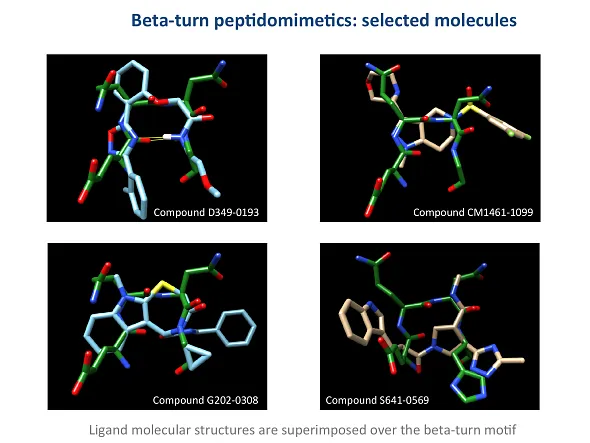Peptidomimetics of Beta-Turn Motifs Library
ChemDiv's Library of Beta-Turn Motifs Peptidomimetics contains 2,679 compounds.
Peptidomimetics are organic molecules designed to emulate the biological activities of peptides. They may structurally resemble peptides, but peptidomimetics significantly differ in their side chains or molecular backbones, offering enhanced stability, bioavailability, and specificity compared to their natural counterparts. A promising strategy for identifying modulators of protein-protein interactions (PPI) involves the use of small-molecule mimetics that replicate the recognition motifs of β-turns. β-turns are among the three primary secondary structural motifs observed in proteins and peptides, characterized by a segment of the polypeptide chain that reverses direction. This structural motif plays a critical role in protein folding and function, making it a target for therapeutic intervention.
There are several types of β-turns, with type I and type II being the most common. In a type I β-turn, the carbonyl oxygen of the peptide bond between the i+1 and i+2 residues is oriented away from the observer, facilitating a specific turn in the polypeptide chain. Conversely, in a type II β-turn, this carbonyl oxygen is oriented toward the observer. Each type of β-turn induces a distinct fold in the peptide chain, which is crucial for the protein's three-dimensional structure and its interaction with other molecules.
Mimicking these β-turn structures with small molecules helps design compounds that can precisely interact with specific protein domains, potentially inhibiting or modulating PPIs. This approach leverages the inherent structural preferences of proteins to develop novel therapeutics that can disrupt pathological interactions without affecting the normal functions of the proteins involved. Through the careful design of peptidomimetics that mimic these critical structural motifs, researchers can create potent and selective modulators of protein function, opening new avenues for drug discovery and development.
Our Helix/Turn 3D-Mimetics library represents a transformative tool in drug discovery, offering a curated collection of small-molecule compounds specifically designed to mimic the key structural motifs of proteins, such as α-helices and β-turns. By targeting these essential components of protein secondary structure, the library facilitates the identification of novel modulators capable of disrupting or enhancing PPIs with high specificity. This targeted approach allows for the exploration of complex biological pathways and the modulation of disease-related proteins that have been challenging to address with traditional small molecule therapies. The library's focus on 3D-mimetic design, leveraging sp3-enriched scaffolds and diversified functional groups, enables the creation of compounds with improved bioavailability, stability, and selectivity. Consequently, it opens up new possibilities for the development of therapeutics across a wide range of diseases, including cancer, neurodegenerative disorders, and infectious diseases, where PPIs play a pivotal role. By providing access to a novel chemical space and fostering the design of innovative drug candidates, the Helix/Turn 3D-Mimetics Library significantly enhances the drug discovery process, offering a pathway to treatments that were previously unattainable.
